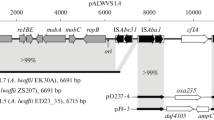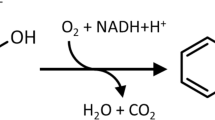Summary
The gene organization of the phenol catabolic pathway of Pseudomonas CF600 has been investigated. This strain can grow on phenol and some methylated phenols by virtue of an inducible phenol hydroxylase and meta-cleavage pathway enzymes. The genes coding for these enzymes are located on pVI150, an IncP-2 degradative mega plasmid of this strain. Twenty-three kilobases of contiguous DNA were isolated from lambda libraries constructed from strains harbouring wild type and Tn5 insertion mutants of pV1150. A 19.9 kb region of this DNA has been identified which encodes all the catabolic genes of the pathway. Using transposon mutagenesis, polypeptide analysis and expression of subfragments of DNA, the genes encoding the first four enzymatic steps of the pathway have been individually mapped and found to lie adjacent to each other. The order of these genes is the same as that for isofunctional genes of TOL plasmid pWWO and plasmid NAH7.
Similar content being viewed by others
References
Bartilson M, Shingler V (1989) Nucleotide sequence and expression of the catechol 2,3-dioxygenase-encoding gene of phenol catabolizing Pseudomonas CF600. Gene (in press)
Cane PA, Williams PA (1986) A restriction map of naphthalene catabolic plasmid pWW60-1 and the location of some of its catabolic genes. J Gen Microbiol 132:2919–2929
Dagley S (1986) Biochemistry of aromatic hydrocarbon degradation in Pseudomonas. In: Sokatch JR (ed) The bacteria, vol X. The biology of Pseudomonas. Academic Press, London, pp 527–556
Franklin FCH, Bagdasarian M, Bagdasarian MM, Timmis KN (1981) Molecular and functional analysis of the TOL plasmid pWWO from Pseudomonas putida and cloning of genes for the entire regulated aromatic ring meta cleavage pathway. Proc Natl Acad Sci USA 78:7458–7462
Frantz B, Chakrabarty AM (1986) Degradative plasmids in Pseudomonas. In: Sokatch JR (ed) The bacteria, vol X. The biology of Pseudomonas. Academic Press, London, pp 295–317
Frischauf A-M, Lehrach H, Poustaka A, Murray N (1983) Lambda replacement vectors carrying polylinker sequences. J Mol Biol 170:827–842
Fürste JP, Pansegrau W, Frank R, Blöcker H, Scholz P, Bagdasarian M, Lanka E (1986) Molecular cloning of the RP4 DNA primase region in a multirange tacP expression vector. Gene 48:119–131
Gibson DT (ed) (1984) Microbial degradation of organic compounds, vol 13. Marcel Deckker, New York
Hanahan D (1985) Techniques for transformation of E. coli. In: Glover DM (ed) DNA cloning, vol 1: a practical approach. IRL Press, pp 109–136
Hansen JB, Olsen RH (1978) Isolation of large bacterial plasmids and characterisation of the P-2 incompatibility group plasmids pMG1 and pMG5. J Bacteriol 135:227–238
Harayarma S, Rekik M, Wasserfallen A, Bairoch A (1987) Evolutionary relationships between catabolic pathways for aromatics: Conservation of gene order and nucleotide sequences of catechol oxidation genes of pWWO and NAH7 plasmids. Mol Gen Genet 210:241–247
Holmes DS, Quigley M (1981) A rapid boiling method for the preparation of bacterial plasmids. Analyt Biochem 14:193–197
Inouye S, Nakazowa A, Nakazowa T (1987) Over-production of the xylS gene product and activation of the xylDLEGF operon of the TOL plasmid. J Bacteriol 169:3587–3592
Inouye S, Nakazowa A, Nakazowa T (1988) Nucleotide sequence of the regulatory gene xylR of the TOL plasmid from Pseudomonas putida. Gene 66:301–306
Kahn M, Kolter R, Thomas CM, Figurski D, Meyer R, Remaut E, Helinski DR (1979) Plasmid cloning vehicles derived from plasmid ColEI, F, R6K and RK2. Methods Enzymol 68:268–280
Karn J, Brenner S, Barnett L, Cesareni G (1980) Novel bacteriophage lambda cloning vectors. Proc Natl Acad Sci USA 77:5172–5176
Kushner SR (1978) An improved method for transformation of Escherichia coli with ColEl derived plasmids. In: Boyer HW, Nicosia S (eds) Genetic engineering. Elsevier/North Holland, Amsterdam, pp 17–23
Loenen WA, Brammer WJ (1980) A bacteriophage lambda vector for cloning large DNA fragments made with several restriction enzymes. Gene 10:249–259
Maniatis T, Frisch EF, Sambrook J (1982) Molecular cloning: a laboratory manual. Cold Spring Harbor Laboratory, Cold Spring Harbor, New York
Ornston LN, Yeh W-K (1982) Reocurring themes and repeated sequences in metabolic evolution. In: Chakrabarty AM (ed) Biodegradation and detoxification of environmental pollutants. CRC Press, Florida, pp 105–126
Sancar A, Hack AM, Rupp WD (1979) Simple method for the identification of plasmidcoded proteins. J Bacteriol 137:692–693
Schell MA, Wender PE (1986) Identification of the nahR gene product and nucleotide sequences required for its activation of the sal operon. J Bacteriol 166:9–14
Shingler V, Bagdarsarian M, Holroyd D, Franklin FCH (1989) Molecular analysis of the plasmid encoded phenol hydroxylase of Pseudomonas CF600. J Gen Microbiol 135:1083–1092
Simon R, Priefer U, Pühler A (1983) A broad host range mobilization system for in vivo genetic engineering: Transposon mutagenesis in Gram-negative bacteria. Biotechnology 1:784–790
Spooner RA, Lindsay K, Franklin FCH (1986) Genetic, functional and sequence analysis of the xylR and xylS genes of the TOL plasmid pWWO. J Gen Microbiol 132:1347–1358
Spooner RA, Bagdasarian M, Franklin FCH (1987) Activation of the xylDLEGF promoter of the TOL, toluene/xylene degradation pathway, by overproduction of the xylS regulatory gene product. J Bacteriol 169:3581–3586
Tsuda M, Minegishi K-I, Lino T (1989) Toluene transposons Tn4651 and Tn4653 are class II transposons. J Bacteriol 171:1386–1393
Yanisch-Perron C, Vieira J, Messing J (1985) Improved M13 phage cloning vectors and host strains: nucleotide sequences of Ml3mp18 and pUC19. Gene 33:103–119
Yen K-M, Gunsalus IC (1982) Plasmid gene organisation: naphthalene/salicylate oxidation. Proc Natl Acad Sci USA 79:874–878
Yen K-M, Gunsalus IC (1985) Regulation of naphthalene catabolic genes of NAH7. J Bacteriol 162:1008–1013
Author information
Authors and Affiliations
Additional information
Communicated by J. Schell
Rights and permissions
About this article
Cite this article
Bartilson, M., Nordlund, I. & Shingler, V. Location and organization of the dimethylphenol catabolic genes of Pseudomonas CF600. Molec. Gen. Genet. 220, 294–300 (1990). https://doi.org/10.1007/BF00260497
Received:
Issue Date:
DOI: https://doi.org/10.1007/BF00260497




